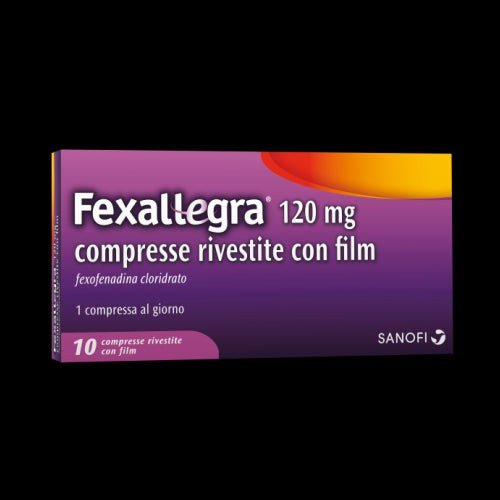
Fexallegra 10 Coated Tablets 120 mg is a drug indicated for the symptomatic treatment of seasonal and chronic allergies, such as allergic rhinitis and urticaria. The active ingredient, fexofenadine hydrochloride, belongs to the category of second-generation antihistamines, known for their ability to effectively reduce allergic symptoms without causing marked drowsiness. Thanks to its 120 mg formulation, Fexallegra acts quickly, with a prolonged effect that lasts up to 24 hours, improving the quality of life during allergy seasons.
Fexallegra is indicated for:
-
Symptomatic treatment of seasonal allergic rhinitis in adults and adolescents aged 12 years and above.
-
Chronic idiopathic urticaria , reducing symptoms such as itching and the appearance of wheals.
ACTIVE INGREDIENTS
Active ingredients contained in Fexallegra 10 Coated Tablets 120 mg - What is the active ingredient of Fexallegra 10 Coated Tablets 120 mg?
One tablet contains: active substance: 120 mg fexofenadine hydrochloride, equivalent to 112 mg fexofenadine. For a full list of excipients, see section 6.1.
EXCIPIENTS
Composition of Fexallegra 10 Coated Tablets 120 mg - What does Fexallegra 10 Coated Tablets 120 mg contain?
Tablet core: microcrystalline cellulose; pregelatinized maize starch; croscarmellose sodium; magnesium stearate. Film coating: hypromellose; povidone K30; titanium dioxide (E171); colloidal anhydrous silica; macrogol 400; red iron oxide (E172), yellow iron oxide (E172).
DIRECTIONS
Therapeutic indications Fexallegra 10 Coated Tablets 120 mg - Why is Fexallegra 10 Coated Tablets 120 mg used? What is it used for?
Fexallegra is indicated in adults and children aged 12 years and above for the symptomatic treatment of allergic rhinitis.
CONTRAINDICATIONS SIDE EFFECTS
Contraindications Fexallegra 10 Coated Tablets 120 mg - When should Fexallegra 10 Coated Tablets 120 mg not be used?
The medicinal product is contraindicated in patients with hypersensitivity to the active substance or to any of the excipients listed in paragraph 6.1.
DOSAGE
Quantity and method of taking Fexallegra 10 Coated Tablets 120 mg - How to take Fexallegra 10 Coated Tablets 120 mg?
Dosage. Adults: The recommended dose of fexofenadine hydrochloride for adults is 120 mg once daily, before meals. Fexofenadine is a pharmacologically active metabolite of terfenadine. Paediatric population. Children aged 12 years and above: The recommended dose of fexofenadine hydrochloride for children aged 12 years and above is 120 mg once daily, before meals. Children under 12 years of age: The efficacy and safety of fexofenadine hydrochloride 120 mg have not been studied in children under 12 years of age. In children aged 6 to 11 years: fexofenadine hydrochloride 30 mg tablets is the appropriate formulation for administration and dosing in this population. Special populations: Studies performed in groups of patients at risk (elderly, patients with renal or hepatic insufficiency) indicate that it is not necessary to adjust the dose of fexofenadine hydrochloride in these patients.
CONSERVATION
Storage Fexallegra 10 Coated Tablets 120 mg - How to store Fexallegra 10 Coated Tablets 120 mg?
This medicinal product does not require any special storage conditions.
WARNINGS
Warnings Fexallegra 10 Coated Tablets 120 mg - About Fexallegra 10 Coated Tablets 120 mg it is important to know that:
Data in elderly subjects and in patients with impaired renal or hepatic function are limited. Fexofenadine hydrochloride should be administered with caution to these groups of subjects (see section 4.2). Patients with pre-existing or existing cardiovascular disease should be informed that antihistamines, as a class of medicinal products, have been associated with adverse reactions such as tachycardia and palpitations (see section 4.8). Fexallegra contains sodium: this medicinal product contains less than 1 mmol sodium (23 mg) per tablet, i.e. essentially "sodium-free".
INTERACTIONS
Interactions Fexallegra 10 Coated Tablets 120 mg - Which medicines or foods can modify the effect of Fexallegra 10 Coated Tablets 120 mg?'
Fexofenadine does not undergo hepatic biotransformation and therefore does not interact with other medicinal products at the level of hepatic mechanisms. Fexofenadine is a substrate of P-glycoprotein (P-gp) and organic anion transporting polypeptide (OATP). Concomitant use of fexofenadine with inhibitors or inducers of P-gp may influence the exposure to fexofenadine; co-administration of fexofenadine hydrochloride with the P-gp inhibitors, erythromycin or ketoconazole has been found to increase the plasma levels of fexofenadine by 2-3 fold. These alterations were not accompanied by any effect on the QT interval and were not associated with any increase in adverse reactions compared to those observed with the same medicinal products administered alone. A clinical drug-drug interaction study demonstrated that co-administration of apalutamide (a weak P-gp inducer) and a single oral dose of 30 mg fexofenadine resulted in a 30% decrease in fexofenadine AUC. No interaction was observed between fexofenadine and omeprazole. However, administration of an antacid containing aluminium and magnesium hydroxide 15 minutes prior to administration of fexofenadine hydrochloride resulted in a reduction in bioavailability, most likely due to binding in the gastrointestinal tract. A 2-hour interval between administration of fexofenadine hydrochloride and antacids containing aluminium and magnesium hydroxide is recommended.
SIDE EFFECTS
Like all medicines, Fexallegra 10 Coated Tablets 120 mg can cause side effects - What are the side effects of Fexallegra 10 Coated Tablets 120 mg?
The following frequency category has been used, where applicable: very common (>= 1/10); common (>= 1/100 and < 1/10); uncommon (>= 1/1,000 and < 1/100); rare (>= 1/10,000 and < 1/1,000); very rare (< 1/10,000) and not known (frequency cannot be estimated from the available data). Within each frequency grouping, undesirable effects are presented in order of decreasing seriousness. In adults, the following undesirable effects have been reported in clinical trials with an incidence similar to that observed with placebo. Nervous system disorders. Common: headache, somnolence, dizziness. Gastrointestinal disorders. Common: nausea. Systemic disorders and administration site conditions. Uncommon: fatigue. In adults, the following undesirable effects have been reported in post-marketing surveillance. The frequency with which they occur is not known (cannot be estimated from the available data). Immune system disorders: hypersensitivity reactions with manifestations such as angioedema, chest tightness, dyspnoea, hot flushes and systemic anaphylaxis. Psychiatric disorders: insomnia, nervousness, sleep disturbances or nightmares/excessive dreaming (paroniria). Cardiac disorders: tachycardia, palpitations. Gastrointestinal disorders: diarrhoea. Skin and subcutaneous tissue disorders: rash, urticaria and pruritus. Eye disorders: Not known: blurred vision. Reporting of suspected adverse reactions. Reporting suspected adverse reactions that occur after authorisation of the medicinal product is important, as it allows continuous monitoring of the benefit/risk balance of the medicinal product. Healthcare professionals are asked to report any suspected adverse reactions via the national reporting system at https://www.aifa.gov.it/content/segnalazioni-reazioni-avverse.
PREGNANCY AND BREASTFEEDING
If you are pregnant or breast-feeding, think you may be pregnant or are planning to have a baby, ask your doctor for advice before taking Fexallegra 10 Coated Tablets 120 mg.
Pregnancy: There are no adequate data from the use of fexofenadine hydrochloride in pregnant women. Limited animal studies do not indicate direct or indirect harmful effects with respect to pregnancy, embryonal/foetal development, parturition or postnatal development (see section 5.3). Fexofenadine hydrochloride should not be used during pregnancy unless clearly necessary. Breastfeeding: There are no data on the concentration in breast milk after administration of fexofenadine hydrochloride. However, when terfenadine was administered to nursing mothers, fexofenadine was found to pass into breast milk. Therefore, the use of fexofenadine hydrochloride is not recommended during breastfeeding. Fertility: There are no data on the consumption of fexofenadine hydrochloride on human fertility. In mice, treatment with fexofenadine hydrochloride showed no effect on fertility (see section 5.3).

























